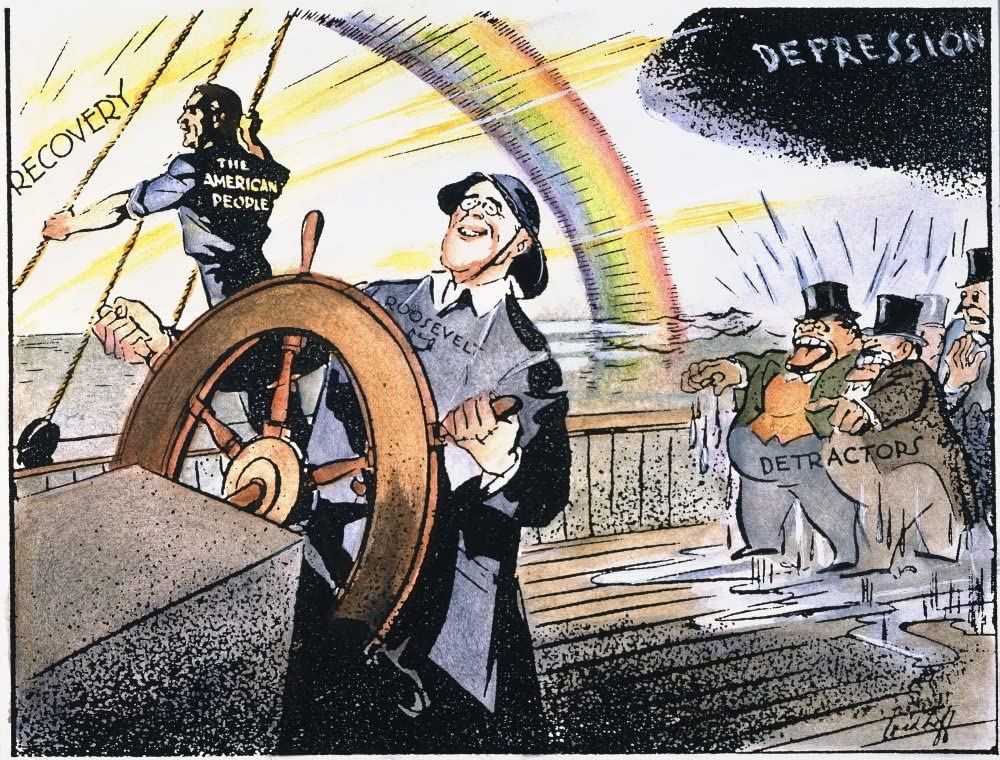
(Although my contributions to this series have so far been more-or-less in their proper order, this one isn’t: it occurred to me only relatively recently that it would be worthwhile to take stock of the overall progress of the recovery up to the outbreak of the Roosevelt Recession before delving into that episode. Had I done this in the first place, this installment would be Part 10 of the series, with the present Part 10 and all subsequent installments moved up a notch. –Ed.)
When it struck down the Agricultural Adjustment Act in January 1936, the Supreme Court dropped the final curtain on the original New Deal. By then the so-called Second New Deal was itself almost complete. On May 6th, 1935, the Works Progress Administration (WPA) took over the federal government’s work relief programs, considerably expanding their scope. The National Labor Relations (Wagner) Act, aimed at reinforcing the National Industrial Recovery Act’s (NIRA) surviving but feeble collective-bargaining provisions, came a month later. The Social Security Act followed that August. The Housing Act of 1937, passed the following September, finished the job. Unlike some parts of the First New Deal, none of these later measures had economic recovery as its chief aim.[1]
That fact should be kept in mind as we take a step back from assessing particular parts of the New Deal to take stock of the overall progress of economic recovery up to mid-1937. How much did economic conditions improve? Does that improvement square with our assessment of the shortcomings of the First New Deal, and of the National Recovery Administration (NRA) especially? If the NRA didn’t help, what did?
A Rocky Start
“Between 1933 and 1937,” Christina Romer says at the start of her famous article, “What Ended the Great Depression,” “real GNP in the United States grew at an average rate of over 8 percent per year.” By her reckoning the unemployment rate also fell substantially, from over 25 percent to under 11. After noting that such gains were “spectacular even for an economy pulling out of a severe recession,” Romer wonders how they can be reconciled with “the conventional wisdom that the U.S. economy remained depressed for all of the 1930s.”
Romer herself offers a partial answer. The collapse of the early 1930s, she says, was “so large that it took many years of unprecedented growth” to make up for it. In fact, the U.S. depression was exceptionally deep, in part because it involved a serious financial crisis, and also because the U.S. took longer than some other countries did to set aside the gold standard.
But a closer look at the record suggests that the recovery wasn’t quite so spectacular as the statistics Romer mentions suggest. For one thing, until mid-1935, the recovery was anything but steady. “After the sharp rise in [industrial] production in the spring and early summer of 1933,” yet another painstaking Brookings Institute study informs us,
there was a substantial recession in the autumn. Through 1934 and the first half of 1935 there were periodic advances followed by more or less corresponding declines. It was not until the middle of 1935 that a strong and persistent advance occurred (p. 77).
Thanks to all those ups-and-downs, despite the great gains made during the Roosevelt administration’s first months, by mid-1935, the index had yet to make up half the ground it lost between the start of the depression and its nadir.
That the “sharp increase in production in the spring and early summer of 1933” didn’t last is not so surprising when one recalls the fact, noted in our review of Brooking’s NRA report, that much of it consisted of a speculative boom informed by the understanding that NRA codes would soon be driving up the prices of both finished goods and inputs.
Spread Thin
Nor were employment gains before 1937 as impressive as Romer’s statistics suggest. Her claim that the unemployment rate fell from 25 to 11 percent relies on Michael Darby’s revised unemployment rate estimates which, as I explained in an earlier installment to this series, overstate the extent of the recovery: although it’s true that persons on work relief weren’t literally unemployed, it’s also true that most weren’t able to find employment elsewhere, so that the number of ordinary employment opportunities is a better guide to the progress of recovery. According to the Bureau of Labor Statistic’s (BLS’s) traditional unemployment rate numbers (also reported by Darby), which reflect the lack of such opportunities by considering those on work relief “unemployed,” in 1937 over 14 percent of workers still couldn’t find ordinary jobs.
But even those BLS figures exaggerate the extent of the employment gains between 1933 and 1937, and particularly between August 1933 and May 1935. As we saw in reviewing Brookings’ NRA report, the decline in the unemployment rate during that time, however one measures it, was almost entirely due to “work sharing” requirements of the July 1933 “President’s Reemployment Agreement,” aka the NRA “blanket code.” That code called on firms to reduce the length of their employees’ work weeks so that available jobs could be shared by more workers. According to Jason Taylor’s estimates, had it not influenced firms’ total demand for labor hours, work-sharing would have created another 2.47 million jobs. But because having three persons each working just under 35 hours a week was more costly than having two working about 50 hours, the code led to a 9.1 percent decline in total labor hours demanded, leaving space for only 1.34 million more employees.
Despite the extra costs it may involve, work sharing can be a reasonable alternative to work relief for keeping people gainfully, if less lucratively, employed during a downturn. But like work relief, although it creates jobs, it does nothing to improve the private economy’s job-creating capacity, understood to mean its total demand for labor hours. As Taylor’s estimates suggest, it can even lower that capacity somewhat.
According to Bob Higgs (2009, p. 152), it wasn’t until some time in 1935 that total non-relief labor hours actually rose above their March 1933 level. The chart below illustrates Higg’s point. In it, the green and blue lines are total civilian labor hours worked, where the blue line includes work relief. The red line crudely approximates potential or full-employment labor hours by extrapolating between the full employment peaks of 1929 and 1949. That procedure allows for the fact that, mandatory work sharing aside, the length of the typical work week gradually declined between those dates. It also ignores the tendency of the labor force to shrink during severe recessions, as unemployed workers get discouraged and drop out of the labor force. (That labor hours employed actually rose above their “full employment” value during WWII reflects intense wartime industrial mobilization efforts, which succeeded in getting roughly 6.7 additional women to temporarily join the labor force.)
A “Progressive” Decade
Such details allow us to reconcile statistics suggesting a “spectacular” recovery with the general consensus that the NRA delayed recovery instead of promoting it, especially by showing how the pace of recovery slowed when the NRA codes went into effect and then improved again as those codes ceased to be complied with, as was increasingly the case in the months before the NRA was struck down.
But the fact remains that, in May 1935, industrial production was 50 percent above its March 1933 level, and that it rose steadily after that for another two years. What part did other New Deal policies play in this indisputably impressive progress?
It’s clear that at least some of the progress had nothing to do with New Deal policies at all. This includes the part due to concurrent, technologically-driven gains in potential output. The progress of recovery is correctly measured not by that of industrial output but by the extent to which the gap between it and potential output has shrunk. A depressed economy that’s producing more and more may still be making slow progress, if not altogether failing to recover, if potential output is also growing.
In fact, potential U.S. output grew very rapidly during the 1930s—so rapidly that economic historian Alexander Field wrote an influential article about it titled “The Most Technologically Progressive Decade of the Century.” “Throughout the Depression,” Field writes (p. 1401),
behind the dramatic backdrop of continued high unemployment, technological and organizational innovations were occurring across the American economy… . [T]he sum total of these changes had, by the onset of World War II, increased the natural or potential output of the U.S. economy far beyond what contemporary observers and economists at the time believed possible.
Field himself puts the average annual growth rate of multifactor productivity during the 1930s at 2.27 percent for the entire private U.S. economy, and at 2.31 percent for the nonfarm economy. Allowing for that last estimate, and also for growth in the full-employment U.S. labor force at an average annual rate of roughly 1.3 percent, reduces the extent of the overall recovery attributable to New Deal policies. But not by much: the red line in the FRED chart below shows how industrial productivity would have increased from its July 1932 trough had labor force and productivity gains alone been at work. That leaves plenty of recovery to be otherwise accounted for.
Great Expectations?
As we’ve seen, neither fiscal stimulus (excepting that from the 1936 army veterans’ Bonus Bill) nor Fed action can account for much of the ’33-’37 recovery. Of remaining possibilities, two stand out. These are Christina Romer’s own explanation, attributing the recovery to gold inflows from abroad, and an alternative view, first put forward by Peter Temin and Barrie Wigmore, and elaborated upon by Gauti Eggertsson, stressing the Roosevelt Administration’s abandonment of conservative “policy dogmas.” Since the U.S. monetary gold stock hardly budged before January 1934, Romer’s theory can’t account for whatever gains took place before then, so if either of the two theories accounts for output gains up to that time, it must be Eggertsson’s.
That improved expectations were part of the story behind the economic turnaround, and initial burst of output, that took place immediately after the March bank holiday, can hardly be doubted. Between them, the suspension of gold payments, the administration’s assurances that the banks it was reopening were sound, and the Fed’s all but explicit promise to supply all the paper currency needed by those who still chose to cash remaining bank deposits, gave people good reason to believe that the era of deflation had ended.
Apart from taking those initial steps, Eggertsson argues, the Roosevelt administration made it clear that it was determined to go to unusual lengths to get prices back up to pre-depression levels, including jettisoning orthodox views on the proper conduct of fiscal and monetary policy. The resulting, positive change in the public’s inflation expectations, he says, translated into a reduction in forward-looking real (that is, inflation-adjusted) interest rates, which in turn encouraged people to borrow and spend more. By means of a calibration exercise using a modified DSGE model, Eggertsson concludes that the New Deal’s abandonment of former “policy dogmas” accounted for a whopping 79 percent of the 127 percent increase in output between March 1933 and July 1937.
But is that figure plausible? Andrew Jalil and Gisela Rua offer support for it in the form of “narrative” evidence, such as news coverage of “inflation,” suggesting that people did indeed anticipate higher prices after FDR suspended the gold standard on April 19th, 1933, and especially after June 19th, when he revealed that he had no intention of subordinating his domestic monetary goals to that of stabilizing currency exchange rates. But Jalil and Rua, along with Eggertsson himself, and Temin and Wigmore, may exaggerate the importance of the public’s altered expectations somewhat by assigning them full credit for the spring 1933 investment “boomlet,” ignoring the part anticipated NRA codes played in it. In any event, instead of lasting, the boomlet was followed by a sharp correction that occurred when the PRA’s blanket code came into effect that August.
Proponents of the regime-change hypothesis also exaggerate the extent to which, after FDR took Hoover’s place, “the focus shifted…from budget balancing to fiscal stimulus” (Temin and Wigmore 1990, p. 490). In fact, as the late Steven Horwitz points out, in the course of a critical appraisal of Eggertsson’s study, and as Julian Zelizer explains in detail, until 1938 the fiscal philosophies of Hoover and FDR were more alike than dissimilar. Both favored a balanced budget under ordinary circumstances, while tolerating deficit spending to provide relief for the unemployed when they couldn’t avoid it by resorting to new taxes. In a passage from his Pulitzer-Prize winning book on the depression to which Horwitz refers (p.79), David Kennedy notes how, once the depression broke out, “Hoover argued strenuously against the budget balancers in his own cabinet,” likening the emergency to a war, and arguing (as Henry Stimson, his Secretary of State noted in his diary) that “in war times no one dreamed of balancing the budget. Fortunately we can borrow.”
In fact, despite somewhat larger deficits, particularly in 1934 and 1936, the Roosevelt administration’s fiscal policy was never expansionary enough to cause any substantial increase in either the price level or employment. “It would be…hard,” Journal of Economic Perspectives editor Tim Taylor says, “to find an economic historian to argue that the primary reason for the drop in unemployment rates from 1933 to 1937 was a surge of expansionary fiscal policy.”[2]
Finally, mere hopes could not boost inflation expectations forever: at some point, those expectations would either have to be fulfilled, or would give way once again to more pessimistic ones. By December 1933, the CPI wasn’t even 5 percent higher than it had been in March. Wholesale prices rose a lot more; but Christina Romer (1999) argues that they did so mainly owing to the NRA codes which, besides directly raising the prices of many commodities, also made them unresponsive to the depression itself, which would otherwise have tended to pull them down. “By setting minimum wages and encouraging firms to base price changes on observable changes in costs,” Romer says, the NRA “prevented the large negative deviations of output from trend in the early recovery period from depressing prices.”[3]
Jalil and Rua themselves conclude that by the end of 1933 the public had come to doubt the administration’s commitment to inflationary policies. It had also become clear by then that, despite record deficits, the New Dealers still didn’t see deficit spending as a means for boosting prices or otherwise stimulating recovery, remaining fiscally orthodox in this regard. And while the gold standard’s suspension, and the dollar’s consequent depreciation, during 1933 gave the public reason to look forward to higher prices, the dollar’s official devaluation in January 1934 suggested that yet another old “policy dogma” was far from dead and buried.
In her paper “Why Did Prices Rise in the 1930s?,” Christina Romer (1999) notes that any direct effect of devaluation on inflation should have been short-lived and limited. She nevertheless goes on to carefully test the hypothesis that devaluation led to a substantial and persistent effect on inflationary expectations, only to conclude that the change did not itself lead people to anticipate ongoing inflation throughout the rest of the decade.
QE Avant Les Lettres
While the 1934 devaluation didn’t directly raise inflation expectations, it did play a part in provoking the gold inflows that Romer elsewhere identifies as the main cause of recovery. By so doing, it would ultimately also help to supply the American public with a new reason to anticipate inflation—albeit one for which unorthodox New Deal policies deserve no credit. And despite its distinct cause, this change in inflation expectations plays a part in Romer’s account similar to the one in plays in Eggertsson’s. “Nominal interest rates were already so low,” she says (p. 775), that “the main way that the monetary expansion could stimulate the economy was by generating expectations of inflation and thus causing a reduction in real interest rates.”
Several studies—Bernanke, Reinhart, and Sack (2004); Anderson (1910); Jaremski and Mathy (2017)—have compared the gold-based expansion of the U.S. stock of high-powered money in the 1930s, and the change in inflation expectations it inspired, to modern central banks’ resort to “Quantitative Easing,” or QE. But changed inflation expectations are only one mechanism by which QE, and its gold-inflow equivalent, might boost output. Another is through the so-called “portfolio balance” effect. By purchasing longer-term securities, central banks reduce the supply of longer-duration assets, reducing the term premium, and therefore the yield, on other long-term as well as medium-term securities. Something like that seems to have occurred in the ’30s as well, when Europeans’ “hot money” was invested in long-term Treasury securities both directly and indirectly through deposits to U.S. banks. According to Christopher Hanes (2019), “trend high-powered money growth” during the thirties, itself driven entirely by gold inflows, “was, in fact, accompanied by substantial declines in medium- and long-term nominal yields.”
The Golden Avalanche
Hanes concludes from the evidence he reports that, like their contemporary counterparts, “American monetary authorities” in the 1930s “follow[ed] policies that increased high-powered money.” But that’s misleading: for the most part, the gold that flowed into the United States after 1934 did so for reasons unconnected to U.S. monetary policy. And while it’s true that American authorities initially tolerated that inflow and its consequences, they did so with growing reluctance, and not for long.
In the late 1920s, when economists spoke of “the gold problem,” they had in mind the shortage of gold stemming from the combination of inflated money stocks, diminished gold output, and—most of all—the maldistribution of existing monetary gold caused by its accumulation in the vaults of the Bank of France and the Federal Reserve system.[4] It has also been generally understood since then that both that gold shortage itself and the way various governments tried to deal with it set the stage for the world depression. So it may come as a surprise to many to learn that, by 1936, instead of complaining that there wasn’t enough gold, U.S. economists and policymakers were worried that there was too much.
Here’s a chart showing the size of the U.S. monetary gold stock, in dollars, showing how rapidly it grew after 1934, after not growing at all for many years. The jump between January and February 1934 reflects the dollar’s official devaluation. Bear in mind that the proceeds from that jump went to the Treasury, rather than to either the Federal Reserve or U.S. citizens whose gold the government had confiscated, so only the subsequent increase was capable of encouraging growth in broader measures of the U.S. money stock.
Several developments accounted for the large-scale gold inflows that reversed the nature of the gold problem. The best know of these was the growing fear, after Hitler became Germany’s chancellor, that war would once again break out in Europe. Besides causing Europeans to shift their savings to the United States, either by depositing them in U.S. banks or by buying American securities ($1.2 billion of which were sold to them between 1934 and 1939), that fear increased the European demand for armaments—a demand that American arms makers were only too happy to help satisfy.
The dollar’s devaluation also contributed to the gold inflow, but not because it did much to improve the balance of trade in the United States’ favor: as Bernanke, Reinhart, and Sack observe (p. 319n33), although it “improved the competitiveness of U.S. exports and raised the prices of imports…in an economy that was by this time largely closed, the direct effects of devaluation seem unlikely to have been large enough to account for the sharp turnaround.” More importantly, because the dollar’s devaluation followed, and was in turn followed by, devaluations elsewhere, after it U.S. goods weren’t conspicuously cheaper than goods elsewhere.[5] Instead, the devaluation mainly mattered because together with those other devaluations it spurred gold production by raising the precious metal’s relative price. The resulting, rapid increase is apparent in the following chart, reproduced from Wikipedia :
So it wasn’t only gold that had been in existence before the depression, but a large share of the dramatic increase in output since, that found its way to the U.S. Treasury, which bought it from the New York banks acting on foreign customers’ behalf, and paid for it with gold certificates. The Treasury’s gold holdings piled up at either the Philadelphia Mint or the New York Assay Office until 1937, when they were transferred to its new Bullion Depository at Fort Knox.
From Russia, without Love
Most newly-mined gold came from mines in the British Empire, and especially from those of South Africa, which in until the mid-1920s accounted for roughly half of world gold output. In 1922, for example, they yielded about 200 metric tons of gold. The Soviet Union’s Siberian mines, in contrast, produced just 6.2 tons of gold that year. But starting around that time, the Soviet government began investing heavily in and centralizing those mines; and as the table below (reproduced from an article by Fritz Lehman) shows, their output grew steadily, to 25 tons by 1929 to 68 tons by 1932 and 185 tons, or almost half of South Africa’s impressive output, by 1936.[6]
Remarking on the vast outpouring of subsidized Russian gold in September 1936 , when authorities at the Bank of International Settlements and elsewhere were predicting further, substantial increases by the end of the decade, Keynes observed—in what might have been a reference to the portfolio-balance argument for QE—that “in the long run” it was “bound to exert a great influence in keeping rates of interest down,” and that its consequent influence on prices was “likely to be steadily upwards.” Russian gold thus removed “the most important obstacle in the way of cheap money.” The means were therefore at hand for ending the world depression, and doing it without resorting to radical policies.
The importance of large supplies of gold now in sight lies in the fact that they may make possible by more or less orthodox methods adjustments, highly desirable in themselves, which we should be less likely to secure by other means. The muse of History is ironically disposed. Communist efficiency [sic] in the extraction of gold may serve to sustain yet awhile the capitalist system.
Were Keynes referring only to the United States, he might have added Nazi bellicosity to Communist “efficiency.” Paradoxically, between them, Stalin and Hitler were now doing more to hasten the U.S. recovery than the American president himself.
Yet, in what is surely, in retrospect at least, one of the most bizarre plot twists in the story of the Great Depression, instead of welcoming all that foreign gold, U.S. authorities came to dread it. What’s more, they came to dread it for precisely the reason that Keynes saw it as a godsend, and that both Christina Romer and Gauti Eggertsson might reckon it so today, namely, because it seemed likely to boost spending and raise prices.
As both the monetary gold stock and bank reserves accumulated—the reserves of Fed member banks more than doubled during the two years following the dollar’s devaluation—U.S. authorities became increasingly concerned that, if conditions improved, either here or abroad, all those bank reserves could prove embarrassing. Europeans might suddenly want their expatriated savings back, upsetting U.S. credit markets. Alternatively, banks might attempt to shed their excess reserves, causing both the money stock and the price level to rise sharply. Because the CPI was still 20 percent below its 1929 level at the end of 1936, that second concern seems odd in retrospect. But many feared that bank lending would revive so quickly that, instead of merely serving to revive business, it would fuel an unsustainable boom.
So it happened that, starting in August 1936, first the Fed and then the U.S. Treasury took steps to limit the risk of inflation from either accumulated reserves or further gold inflows. Thanks to this reaction to them, the same gold flows that helped revive the U.S. economy between 1934 and 1937 helped bring about the disastrous reversal that was to erase most of those gains. The muse of History is, indeed, ironically disposed.
____________________
[1] Some authorities label Roosevelt’s post-1936 domestic policies and reforms, and particularly those that followed the 1937 recession, a “Third New Deal,” distinguished from the others by its abandonment of more radical reform efforts in favor of “Keynesian” fiscal policy. On this change in emphasis see Jeffries (1990) and the present series’ three installments concerning “The Keynesian Myth.”
[2] In defense of their claim that Hoover was more fiscally orthodox than Roosevelt, Temin and Wigmore (1990, p. 487) observe that “[h]e successfully sponsored a massive tax increase in late 1931 in an effort to recoup the precipitous decline in federal tax revenues. The maximum personal income tax rate rose from 2.5 to 63%. Corporate income taxes rose, estate taxes were doubled, and gift taxes were reintroduced. Hoover’s opposition to the veterans’ bonus reveals the depth of his opposition to expansionary policies; the bonus was handed to him with no political risk and a rationale that allowed him to maintain its ideological purity. Hoover still declined this offer.” They neglect to mention that FDR retained Hoover’s 63 percent marginal tax rate through fiscal 1936, when he raised it to 79 percent, where it remained through the end of the decade; that FDR also raised corporate tax rates considerably; and that he raised the maximum estate tax rate from 45 percent to 60 percent in 1934, and to 70 percent in 1935. Nor do they point out that Roosevelt was no less opposed to early payment of the veterans’ bonus than Hoover and every other president since Wilson had been, and that he opposed it on deficit-reduction grounds. Roosevelt vetoed bonus bills in both 1935 and 1936, going to the length of addressing Congress to defend the first veto. The exceptionally large 1936 budget deficit came about only because Congress succeeded in overriding the second.
[3] In a paper that’s meant to complement his 2008 study, Eggertsson (2012) claims, controversially, that instead of inspiring a temporary boom only, and otherwise hampering recovery, the NRA codes actually aided recovery, and did so in a manner analogous to that of anticipated monetary or fiscal stimulus. By raising inflation expectations, he says, the codes could also have lowered anticipated real interest rates despite a binding zero lower bound on nominal rates. Although Eggertsson recognizes the obvious difference between expansionary monetary or fiscal policy, which raise prices by directly boosting aggregate demand, and the NRA codes, which were more like an adverse supply shock, he neglects the possible effect of the shock on what he calls the “efficient” (real) interest rate, which he treats as an exogenous variable dependent only on consumers’ intertemporal preferences. If, instead, one allows it to depend on anticipated industrial productivity, while also allowing that the NRA codes were expected to have a lasting adverse effect on that productivity (which would not have been a unreasonable assumption), the codes would have reduced the efficient rate. In that case, despite higher expected inflation, the zero lower bound might have stayed just as binding as before. For skeptical views, appealing to both empirical evidence and theory, of the New Keynesian argument that adverse supply shocks can boost output, see Cohen-Setton, Hausman, and Wieland (2017) and Wieland (2019).
[4] See the interim (1930) and final (1932) reports of the Gold Delegation of the League of Nation’s Financial Committee, and especially the dissenting observations in the latter report by M. Albert Janssen, Sir Reginald Manx and Sir Henry Strakosch (pp. 64-73) and Gustave Cassel (pp. 74 -75), all of whom regarded the hoarding of gold by France and the United States, rather than any overall gold shortage, as the chief cause of trouble. See also Patricia Clavin and Jens-Wilhelm Wessels’ fascinating discussion of the Gold Delegation’s controversial origins and proceedings, emphasizing how its inquiry into the gold “shortage” had been intended by British authorities as a politically safe way to draw attention to the threat U.S. and French policies posed to sterling’s stability.
[5] As Frank D. Graham explained in 1935, “With so many countries devaluing in almost equal degree, at a time when deflation rather than inflation had been in progress, there has been a strong tendency for the price structure in the devaluing countries to become the dominating factor in the world situation and thus to shift the burden of adjustment upon the countries which were maintaining the original gold content of their currencies. The devaluation of currencies in terms of gold did not result in a devaluation of the currencies in terms of commodities but rather raised the general commodity value of gold. Instead of the price structure in gold standard countries serving as the lode-star round which other price structures turned, the center of gravity was shifted to the modal bloc of currencies of approximately equal devaluation. Prices in these currencies are today practically the same as they were in September 1931, while in the countries of the gold bloc there has been a fall of from 15 to 20 per cent.”
[6] A comparison of Lehman’s table with one found in the 1932 report of the League of Nation’s Gold Delegation, showing estimates of future gold production supplied to it, reveals just how far reality ended up veering from those estimates:
Continue Reading The New Deal and Recovery:
Intro
Part 1: The Record
Part 2: Inventing the New Deal
Part 3: The Fiscal Stimulus Myth
Part 4: FDR’s Fed
Part 5: The Banking Crises
Part 6: The National Banking Holiday
Part 7: FDR and Gold
Part 8: The NRA
Part 8 (Supplement): The Brookings Report
Part 9: The AAA
Part 10: The Roosevelt Recession
Part 11: The Roosevelt Recession, Continued
Part 12: Fear Itself
Part 13: Fear Itself, Continued
Part 14: Fear Itself, Concluded
Part 15: The Keynesian Myth
Part 16: The Keynesian Myth, Continued
Part 17: The Keynesian Myth, Concluded
Part 18: The Recovery, So Far
The post The New Deal and Recovery, Part 18: The Recovery So Far appeared first on Alt-M.








